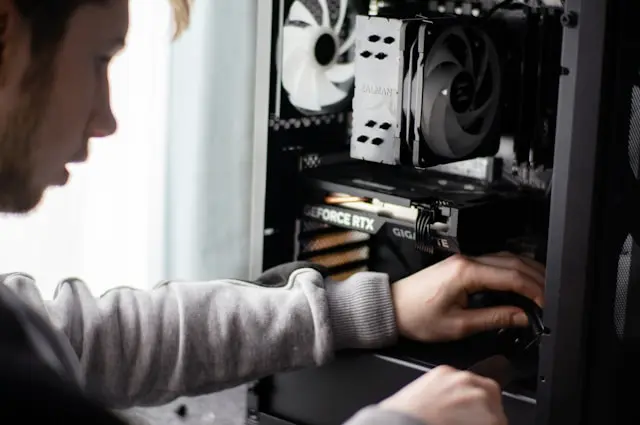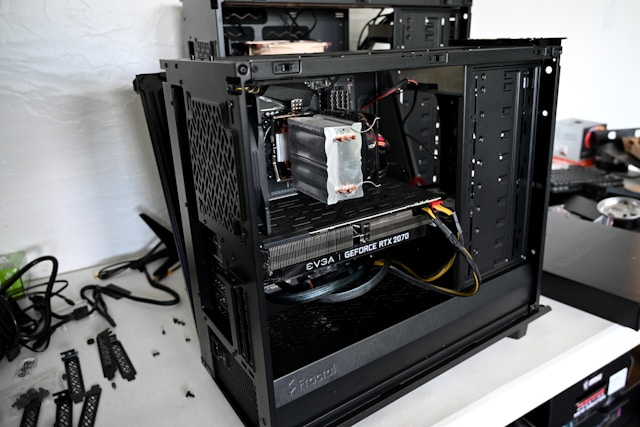The laptop is overheating, the battery lasts less and less, and the computer is slow even with basic tasks? Most people procrastinate until "I'll check it out this weekend" turns into lost files and expensive repairs. The good news: with timely hardware diagnostics and proper maintenance, many issues can be prevented. In this guide, you will find a clear plan on when to seek computer repair services, what professional repair includes, how to compare offers, and how to extend the life of your equipment.

The most common signs that it's time for service
• Overheating and noise – the fans are "whining," the case is heating up. Often resolved by cleaning the laptop and replacing the thermal paste; neglect can damage the motherboard/video chip.
• Slow performance/freezing – possible bad disk, filled storage, problematic RAM, or software issues. Diagnosis + reinstallation of Windows and migration to SSD helps.
• The battery drains quickly – natural wear; a replacement with a compatible/original module is needed.
• Charging/port issues – worn connector, cable, charger. Often resolved with repair/replacement of the DC jack.
• Noise/clicking from the disk – data recovery first, experiments – later. Then a new medium is installed.
💡 Important: Preventive maintenance every 6–12 months costs less than "rescuing" an overheated laptop.
What does the computer service actually do
Professional computer repair begins with hardware/software diagnostics: RAM testing, SMART checks on drives, temperature monitoring, stress tests, and driver verification. The next steps include: cleaning the laptop, replacing thermal paste, replacing the fan, replacing the battery, repairing the connector, and reinstalling Windows with data backup. If necessary – upgrading to SSD, adding RAM, calibrating the battery, and power supply maintenance.
Useful reading: The true cost of poorly executed cleaning of houses and villas
How long and what determines the price
• Type of problem: prevention is faster than repairing a motherboard.
• Parts and inventory: batteries/fans/SSDs – often available; specific connectors/boards – upon request.
• Software/OS: reinstalling Windows with data transfer takes more time than a regular "tune-up."
• Urgency: the express service costs more, but it saves projects/deadlines.
It makes sense to request a breakdown by activities (diagnostics, parts, labor, time, warranty) and to compare 2–3 personalized offers.
Myth / Fact
Myth: "I will blow the dust and it will pass."
Fact: dust is everywhere in the cooling system; disassembly, laptop cleaning, and thermal paste replacement are needed. Otherwise, overheating will return.
Myth: "Reinstallation kills the data."
Fact: a good service makes a backup and restores the files (and sometimes even the settings) in place.

How to Compare Offers Fairly
1. Diagnosis – whether it is paid and if it is deducted from the repair.
2. Specifics – parts by model, term, labor warranty, and components.
3. Data – how it is archived and protected (GDPR, privacy).
4. Replacement vs. repair – sometimes replacing a battery/fan is more sensible than "restoration".
5. Maintenance – preventive care, cleaning after 6–12 months, software checks.
List of questions: 10 important questions to ask the contractor before starting the project – ideal checklist for service.
Mini case: "it was just making noise, and then it went out"
Laptop with a noisy fan and high temperatures. The client delays for 4–5 months. Result: overheated video chip, random restarts, lost hours of work. The service performs hardware diagnostics, laptop cleaning, thermal paste replacement, SSD upgrade, and power supply maintenance. Time: 1 day. Effect: quieter computer, lower temperatures, faster performance, longer lifespan.
💡 Tip: if the fan is whistling and the case is heating up, don't run stress tests – first do maintenance.
Frequently Asked Questions
How often should I perform maintenance? Every 6–12 months for laptops; for a desktop computer – depending on dust/load.
Will I lose my data? For standard repairs – no. The service should offer backup/migration.
Is there any point in upgrading? Yes – an SSD and more RAM have a significant real effect.
How long does the reinstallation take? Usually 2–4 hours + migration/drivers, depending on the scope.

How to extend the life of your equipment
• Do not constantly work on a pillow/blanket – the cooling gets suffocated.
• Use original power supplies.
• Dust the area around the workspace.
• Monitor temperatures (without getting obsessed).
• Plan for prevention and archiving – data recovery is the last resort, not a strategy.
Conclusion:
Timely diagnostics and maintenance save nerves and money. If you have overheating, noise, slow performance, or issues with the battery/charging – don’t delay. Choose a reliable computer service, compare clear offers, and give your equipment a chance to work long and smoothly.